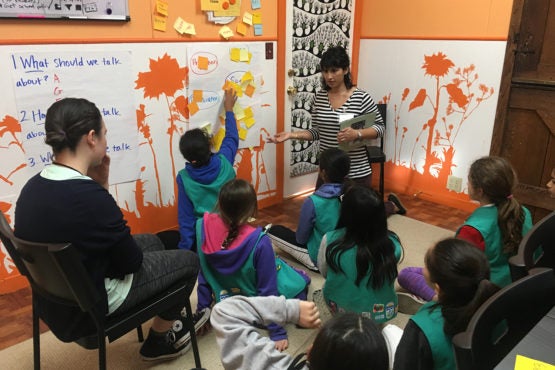May 24, 2021
Stanford researchers reveal environmental learning in unexpected places
A wide range of organizations focused on areas as seemingly disparate as social justice, religion and the arts play important roles in helping people understand and act on environmental issues. Stanford environmental experts discuss their analysis of nearly 1,000 such organizations in the San Francisco Bay.
Every breath, bite and sip we take is a reminder that no barrier separates humans from the environment. Because so many fundamental parts of our lives are intertwined with the broader world, it may come as little surprise that a wide range of organizations focused on areas as seemingly disparate as social justice, religion and the arts play important roles in helping people understand and act on environmental issues.

Girl Scouts in Palo Alto, Calif. prepare to survey community members about the expansion of a local museum and zoo that provides science and environmental education. (Image credit: N.M. Ardoin)
A Stanford study, published May 22 in Environmental Education Research, identifies nearly 1,000 organizations in the San Francisco Bay Area alone that create an interconnected web of opportunities for learning about and taking action on environmental issues. The providers, from those that are top-of-mind to the less-expected, work together to ensure that environmental learning is a “lifewide, lifelong” process.
The analysis was coauthored by Deborah Wojcik, a former postdoctoral researcher at Stanford and current managing director of graduate student programs and services at Duke University’s Pratt School of Engineering; Nicole Ardoin, an associate professor at the Stanford Graduate School of Education and Rachelle Gould, alumna of the Emmett Interdisciplinary Program in Environment and Resources (EIPER) in the School of Earth, Energy & Environmental Sciences and former postdoctoral researcher at Stanford. Currently, Gould is an assistant professor at the University of Vermont’s Rubenstein School of Environment and Natural Resources.
Below, Wojcik, Ardoin and Gould explain the “community ecosystem of environmental learning” that the article describes and discuss how boundary-spanning organizations can help empower people to make positive change in their communities.
How might an organization that has seemingly nothing to do with the environment, such as a community center or food bank, play a key role in providing opportunities for environmental learning?
Where and how we source our food, as well as what food we decide to purchase and why, have enormous implications not only for our personal health and that of our family but also for our wider community and the broader ecosystem. Food banks, as institutions, thus represent trusted community gathering sites that offer learning opportunities. These places and others can emphasize, for example, the benefits of a vegetable- and whole-grain-based diet for human and planetary health.
Similarly, a community center might host a town hall discussion on neighborhood transportation options; support design charrettes to create and improve safe biking routes to school; and collaborate in a consortium that provides human, financial and capital resources to create a greenbelt from a rails-to-trails effort.
Why might your study be of interest to marginalized communities? Is there a connection to environmental justice?
Many, if not most, environmental issues are also justice issues. The organizational network we describe demonstrates many instances of organizations whose primary focus is social justice collaborating with organizations whose primary focus is the environment, and vice versa.
For marginalized communities and organizations composed of those traditionally underrepresented in the environmental space, we hope these findings help highlight some of the critical work that they are already doing and have been doing for decades. For others, we hope to offer ideas of potential avenues toward richer and more authentic collaboration.
What might organizations that only tangentially focus on the environment be interested to learn from your work?
We found that geographic proximity – which in our study means that organizations share a “home county” – was a strong determinant of the groupings that emerged. Sharing a common place seemed to motivate organizations to also share resources, space and information and to actively support each other’s organizational missions. The organizations often worked together to create a stronger sense of place and then focused collective efforts to “grow the pie” of resources benefitting that shared place.
Those strong collaborations not only supported the environmentally-focused organizations but also allowed the networked organizations to build their own momentum around community engagement, enhancing coherence and relevance in their constituents’ lives.
What can environmental organizations, such as the national Sierra Club and local land trusts, do to build coalitions with organizations we don’t typically think of as environmentally focused?
Many national- and regional-scale groups partner through efforts such as the Outdoors for All initiative, which supports enhanced universal access to nature. Others, such as the National Recreation and Parks Association and the Golden Gate National Parks Conservancy, collaborate with healthcare providers on initiatives such as park prescriptions, a range of programs aimed at improving wellbeing through nature experiences. These programs seek to amplify the benefits of nature-rich settings for physical and mental health. Notably, such partnerships have been expanding, along with the overall amount of time spent outdoors and on public lands, among age all groups over the past year in particular.
Ardoin is also the Emmett Faculty Scholar, the Sykes Family Director of the Emmett Interdisciplinary Program in Environment and Resources (E-IPER) in the School of Earth, Energy & Environmental Sciences (Stanford Earth) and a senior fellow at the Stanford Woods Institute for the Environment. Read more about her Social Ecology Lab.
To read all stories about Stanford science, subscribe to the biweekly Stanford Science Digest.
-30-
|